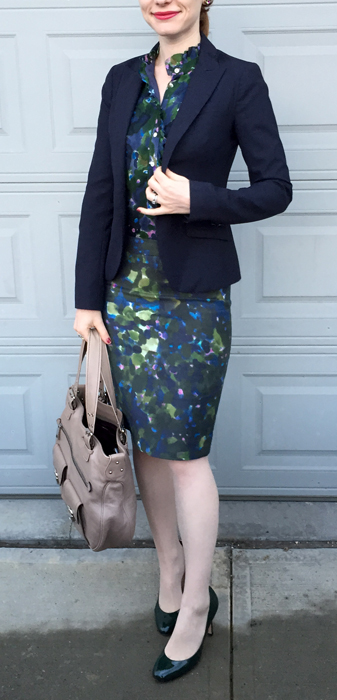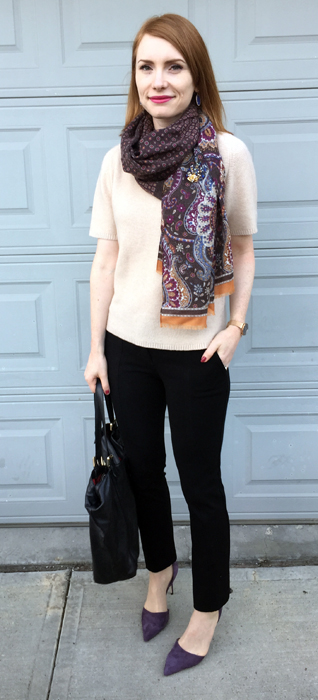A reader posed an interesting question on a recent thrifting post, and after thinking through my response to her, I decided it would make a good topic for a post of its own. With her permission, I am reproducing the question here (in condensed format), to kick things off:
What do you consider a good price on really high end pieces? For example – I need a new coat that goes over business suits and found a beautiful Italian cashmere coat that looked unworn. Fits beautifully. Price is ~10% of full retail (I researched) – but retail is over $3K. So it seems pricey but the quality and fit are amazing. I noticed a trend for the cost of better designer stuff [on the secondhand market] to be about 10% of retail. Good? Bad?
Boiled down to its essence, this is a question that most thrifters (and fans of secondhand shopping generally) have to face: how do you judge “good value”? Here are my two cents on that.
Retail Value as Benchmark
As reader SAK suggested, using the retail value of an item as a benchmark is one way of determining whether its re-sale price is “good value” or not. There are several things about this method that I like, as well as some drawbacks I’ll address in a minute. First of all, we are wired to assess value through comparison, so this approach taps into that. Getting something for $5 when the original price tag was $250 feels like “good value” and sometimes that’s as objective an answer as we can get. Moreover, higher retail value generally correlates with better quality, which means that our objective feelings might have some grounding in reality.
But, as I mentioned, there are drawbacks too. Retail value can be, on occasion, hard to determine – especially with pieces older than 2-3 years, which is what you might typically expect to find in secondhand stores. Dedicated thrifters like me have learned the Google tricks that will yield the most useful results, but even we can be stumped at times. As well, retail value is sometimes misleading as an indicator of quality. There are $250 sweaters that are appreciably better than $100 sweaters, and some that are no better, or perhaps worse in quality. There is probably little difference between a $250 sweater and a $350 one. There is almost certainly no difference between a $350 sweater and a $700 one, unless the latter is weaved by fancy French elves from the discarded hairballs of the legendary Choupette. Fabrics and finishes can provide some clues as to the real manufacturing cost and, hence, the mark-up involved in the retail price. (Ethical manufacturing is an even bigger clue.) And here’s a hypothetical question: would a $5 sweater that retailed for $250 seem as good of a bargain if you knew it cost $25 to produce?
Going back to SAK’s original query, I think that 10% is not a bad benchmark if you’re judging value based on retail price. Clothing depreciates way faster than cars, you guys! As soon as you cut those original tags off, the value typically drops by 20% or more. Wear the piece a few times, and you’ll be lucky to get 40% of its retail value … and that is if you can sell it directly (i.e. eBay or Poshmark) rather than through a third party (i.e. consignment), and if the piece is from a brand with good “resale value” – which is not necessarily the same as brand cachet. Looking at it from the buyer’s perspective, that’s good news: you can easily score things for 10% or less than retail value, particularly at thrift stores. My current average for the year (not counting bags, since I tend to buy high-end designer pieces at consignment stores, which skew the results a lot) is just over 5%. I’m probably not the best example, since I’m more than a casual thrifter, but 10% is totally doable for most people with access to decent thrift stores.
Price Set Points
For most thrifted pieces, price set points don’t really come into the picture. A price set point is the highest amount a person feels comfortable paying for a particular item of clothing. This can vary from item to item, and from person to person. I always find it interesting to talk to people about their price set points because they are often vastly different from mine, and it’s fascinating to hear the explanations for those differences. Anyway, most people are willing to spend $20 or less on any one piece of clothing, so price set points are not usually helpful in assessing “good value” when it comes to thrifting. SAK’s example, on the other hand, serves as a good illustration of when this approach can be helpful.
Is $300 too much to spend on a coat — irrespective of how beautiful or useful that coat might be? If you answered “no”, you might have a hard time imagining that someone would ever say “yes”, but I assure you that such people exist. I used to be one of them. (To be honest, I would still have a hard time spending $300 on a coat today, even though I did spend nearly as much on my MaxMara coat and never regretted it.) Here is another example: would you spend $2,000 on a bag? What if it was a $20,000 Hermes Birkin? Some people might say “yes” — to the Birkin — others will say “no” to the price out of hand — Birkin or no Birkin.
Price set points can provide another benchmark against which to assess “good value”. If your price set point for a coat is $500, then a $300 coat that meets all your functional and aesthetic criteria is a good deal. If your price set point is $300, then the same coat might be less impressive of a deal … unless you consider other benchmarks in conjunction with the price set point (like the retail value). In fact, I usually do that. Over time, I have developed a thrift version of price set points — like, $20 for dresses, $10 for pants, $10 for blazers, etc — but they can nudged upwards by things like original retail value.
And that is one of the main downsides of price set points generally: over time, they tend to fluctuate … typically in one (upward) direction. My bag collection is proof of that. Sigh.
Cost per Wear Calculations
As a statistics nerd, I love the concept of cost-per-wear. I track it for all my clothing and accessories … which is how I know that I (along with most people, I would imagine) am pretty terrible at estimating it. I tend to greatly over-estimate how many times I will wear a particular item, and for how long. That’s partially a function of the fact that I have a ton of clothes; no matter how much I might love a piece when I buy it, the reality is that it will be competing for wears with a lot of other stuff. Unless we’re talking about committed minimalists, the same applies (to a lesser extent) for most of us. Obviously, I don’t think that having more clothes than strictly functionally necessary is a bad thing; I think variety is fun. But it’s something that needs to be factored into CPW calculations and often isn’t.
Let me give you an example. I’m a dress person. On average (counting weekends), I wear dresses at least 2-3 times per week, year-round. Using the lower estimate, that’s 104 dress wears per year. Now, I won’t tell you how many dresses I own, because I don’t want to horrify you, but let’s use a fairly conservative number: let’s say I had 10 dresses in total. (Hahahahaha!) Assuming I wore all my dresses equally, that means each dress would get less than 11 wears per year. Now, let’s take a new dress, with a $100 price tag. If it went into my annual rotation, alongside my other dresses (and I did not purge another dress to make room for it), it would take over 10 years before the CPW of that dress became $1 … assuming I didn’t buy any more dresses after that … and that I still had the dress, 10 years later. In my case, it’s unlikely that either of those assumptions would bear out.
CPW rarely helps me decide if something is good value at the thrift store — a cute dress for $5 is ALWAYS a good deal, as far as I’m concerned — but it helps a great deal when I’m at the mall. Unless, I’m considering something I’ve already tried and failed to find at the thrift store (and the item in question is *precisely* what I’m looking for), CPW is usually the thing that deters me from getting out my wallet. When you’ve got as large a closet as I do, and as many thrifting options, it’s hard to justify retail prices.
Phew, that was quite the dissertation. Your turn: tell me how you decide if something is “good value”?







